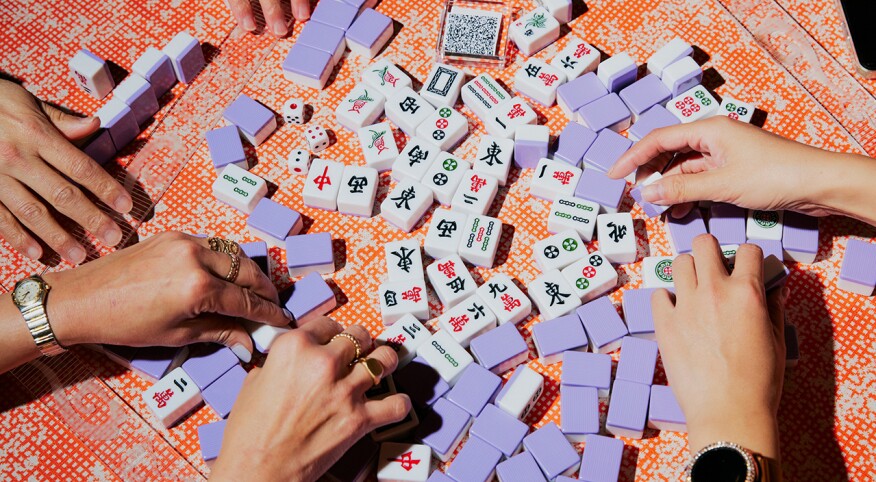Do you love to travel? Do you love to get travel tips? Then join our closed Facebook group, The Ethel-On-The-Go, today!
I inherited my mother-in-law’s old mah-jongg set after she switched to bridge. My daughter was surprised. “That’s what old ladies play!” she said.
She’d been to my mother-in-law’s community room: table upon table filled with clacking tiles and shuffling cards, as foreign to my daughter as life before smartphones.
My attraction to mah-jongg began as a kid at the Palm Shores, a chic name that didn’t match this urban middle-class pool club. Topless men and skirted-swimsuit wives played in a mosaic of card tables. My friends and I were in our never-ending awkward stage, yet we unabashedly gyrated during afternoon preteen dances on a terrace above the snack bar. We’d sneak into the steam room to view the naked ladies whose breasts astonished us as we were still in training bras.
One day, we borrowed a mah-jongg set and began to play every day while our peers had water fights in the pool.
“How cute!” every grandma remarked, passing us during their own game breaks to eat homemade lunches in plastic containers in their cabanas.
One bam. Two cracks. Flowers, dragons, winds. We’d dump our tiles face down into the center of the table, jointly mix the ivory rectangles with vigor, and begin a new game. We yearned to be very grown up. We thought we were cool.
Today, mah-jongg is having a resurgence, especially among younger generations.
Developed in China in the Qing Dynasty, mah-jongg is similar to gin rummy. The National Mahjong League has 500,000 members.
At my first game since I was in braces, I invited three friends who merged into a seamless perimeter around my fold-up bridge table. My eyes glazed over when I saw all the different tile configurations. How could I absorb this into my overloaded mind when I couldn’t remember where I’d left my reading glasses?
“It’ll come back quickly,” promised Linda, an experienced player. She suggested we play open hands to start. Each player had to “commit” to a “hand” on the mah-jongg card from dozens of options of pairs, triples, and quintuplets in three suits, flanked by dragons, flowers, and winds in four directions.
I kept picking up jokers.
“Aren’t you lucky!” enthused Linda, my coach.
Nothing was coming back to me, as if I’d never been a young prodigy of this ancient game. I took pride in the narrow scope of professional wisdom I’d acquired over the years, explaining concepts each semester to puzzled college students. Yet, I hadn’t tried to learn anything new in a while.
“Mah-jongg!” Linda proudly exclaimed, winning again.
I tried not to act like a humiliated loser.
Why did I have to feel so competitive about a silly game? I hated feeling clueless. And I’d been lazy lately, not pushing my brain cells into new territory. I was no longer that teenager who absorbed information like a sponge.
I didn’t want to give up, especially because researchers report that mah-jongg players appear to have sharper minds and a more long-lasting memory. The game may help prevent or delay dementia, according to Dr. Linda Sasser in Brain and Memory Health. There was even a Chinese American diplomat who worked at the U.N., a passionate player who lived to 111.
Cognitive skills improve even if you play infrequently: attention, pattern recognition, quick decision-making and the challenge of annual mah-jongg cards with new winning combinations to learn.
I decided to join a free AARP mah-jongg offering. The longer I examined the mah-jongg card, the more it made sense. I loved the patterns, the colors and the mathematical thinking required to predict which hand you could win through skill and luck. I watched a YouTube video featuring a co-ed group of Chinese players. I practiced playing online.
Months later, I was ready to move up the mah-jongg ladder. I’d inherited something more meaningful from my mother-in-law than a strand of pearls that neither I nor my daughter would ever wear.
“One of the most important lifestyle practices for better brain health is socializing,” says Dr. Sasser, who emphasizes that conversation between players affects one’s overall happiness, allows you to meet new people, and enables you to form new friendships.
I organized a weekly game, alternating locations at each other’s houses. This game was not only about competition, but it was also fun. I began to cherish the aesthetics and feel of the tiles in this multi-generational pastime. Even more, every time I brought out my new set in a faux snakeskin case, I felt re-connected to my mother-in-law, running my fingers over her elegant ivory tiles.
Do any of you play mah-jongg? Do you love it? Let us know in the comments below.

Jennelle Fong
Follow Article Topics: Lifestyle








